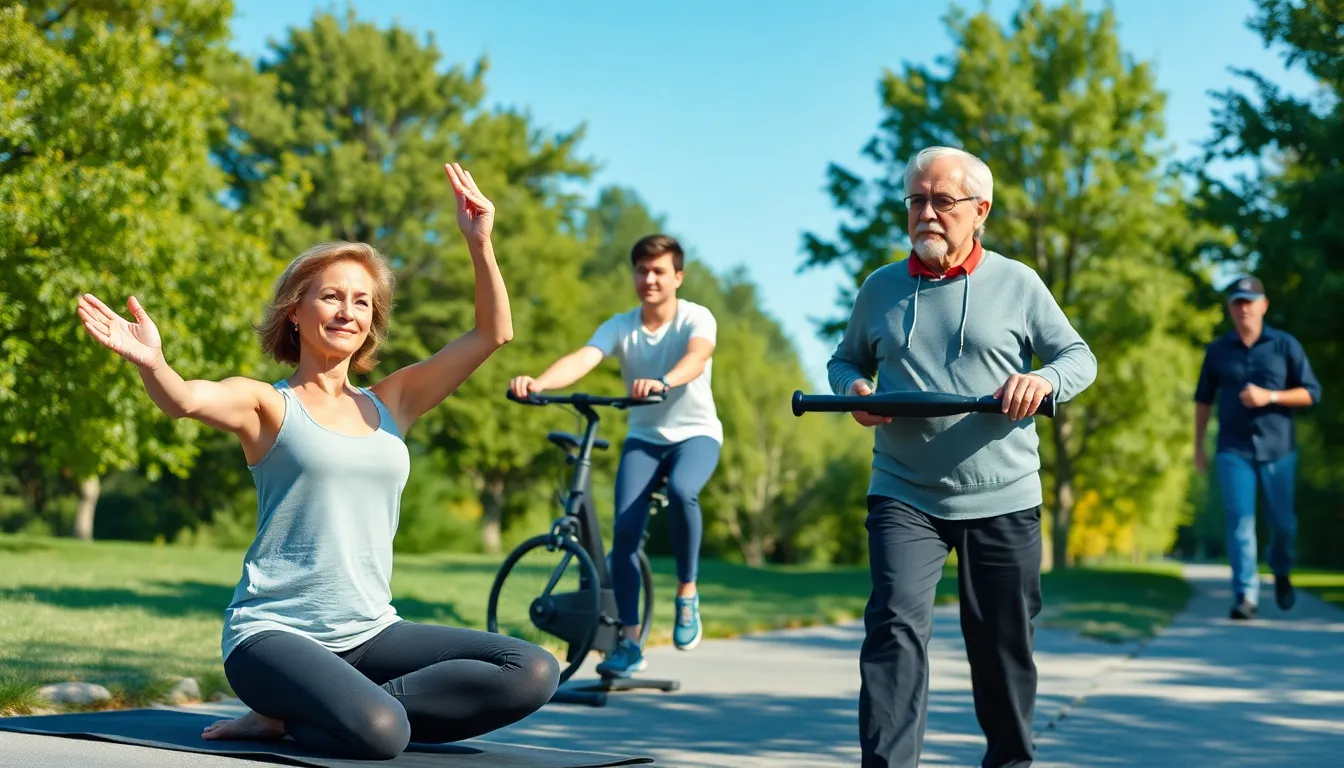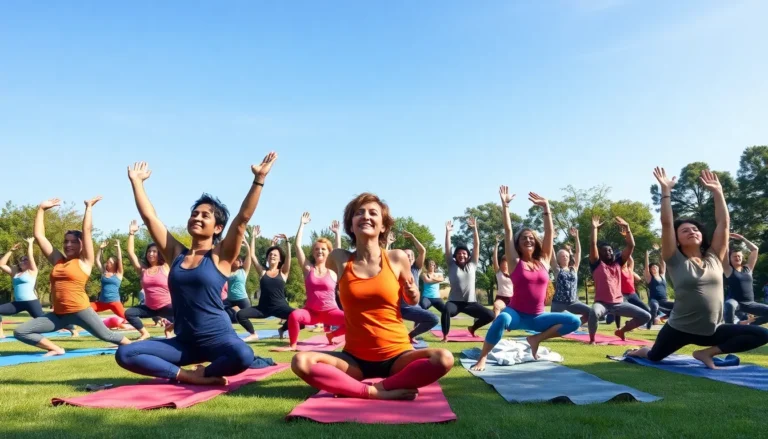Table of Contents
ToggleIn a world where high-intensity workouts reign supreme, low-impact workouts often get overlooked. But let’s face it, not everyone wants to feel like they just survived a zombie apocalypse after a gym session. Low-impact workouts offer a refreshing alternative that keeps the heart happy without making the knees scream for mercy.
What Are Low-Impact Workouts?
Low-impact workouts consist of exercises that minimize stress on the joints while still delivering cardiovascular and strength benefits. Such workouts typically involve movements performed at a steady pace, making them suitable for a wide audience. Individuals with joint concerns, or those recovering from injuries, often find these workouts especially beneficial.
Common examples of low-impact workouts include walking, swimming, cycling, elliptical training, and yoga, among others. These options engage various muscle groups without subjecting the body to high-impact forces. Low-impact workouts promote heart health and improve endurance, which can lead to weight management and enhanced overall wellness.
Many people appreciate the versatility of these workouts, as they can be adapted to different fitness levels. For example, a beginner might start with walking, while an experienced individual may choose more challenging sessions like cycling or swimming laps. Groups or classes often incorporate low-impact exercises, making social interaction a part of the experience.
Engaging in low-impact workouts also allows participants to maintain their fitness regimen without risking injury. Athletes or those returning from injuries can use these activities to build strength progressively. Their structured nature complements high-intensity training days, promoting a balanced fitness approach.
Ultimately, incorporating low-impact workouts into a fitness routine can yield substantial health benefits while ensuring safety and enjoyment.
Benefits of Low-Impact Workouts

Low-impact workouts offer several key benefits that cater to diverse fitness needs and preferences. Understanding these advantages can motivate individuals to incorporate such exercises into their routines.
Improved Joint Health
Low-impact workouts prioritize joint health by minimizing wear and tear. Exercises like swimming or cycling promote circulation without jarring movements. Reduced strain on joints enables individuals to maintain an active lifestyle, even with pre-existing conditions. Regular participation helps alleviate symptoms associated with arthritis or injuries. Flexible movements enhance joint mobility while strengthening surrounding muscles. Engaging in these workouts fosters longevity in fitness routines, ensuring consistent activity over time. Maintaining joint health leads to improved overall functionality and mobility.
Increased Accessibility
Accessibility defines low-impact workouts, making them suitable for a wide range of fitness levels. Beginners find these exercises less intimidating and easier to adopt. Options such as walking or yoga require minimal equipment, making them easy to start. Individuals recovering from injuries appreciate the gentler approach that still provides benefits. Group classes or at-home routines let people choose their settings. Adaptability allows modifications for different fitness levels, ensuring everyone can safely participate. Establishing an inclusive environment encourages more individuals to pursue their fitness goals.
Popular Types of Low-Impact Workouts
Low-impact workouts offer a range of activities that cater to different preferences and fitness levels. Each type provides unique benefits while minimizing stress on the joints.
Swimming
Swimming stands out as a comprehensive low-impact workout. It engages multiple muscle groups and improves cardiovascular health without straining joints. Water’s buoyancy supports the body, reducing the risk of injury. A 30-minute session can burn approximately 200 to 400 calories, depending on intensity. Swimming laps or participating in water aerobics adds variety and enjoyment while building endurance.
Yoga
Yoga combines strength, flexibility and relaxation in a low-impact format. Various poses enhance muscle tone while promoting balance and joint health. Practicing regularly can alleviate stress, improve posture and enhance focus. Sessions can range from gentle stretching to more intense flows, catering to all fitness levels. Research indicates that even short yoga practices can lead to significant improvements in overall well-being.
Cycling
Cycling provides an excellent cardiovascular workout without harsh impacts on the body. Individuals can choose between stationary bikes or outdoor cycling for variety. A typical hour of moderate cycling can burn around 400 to 600 calories, depending on speed and terrain. Regular cycling sessions strengthen lower body muscles and improve stamina, making it a popular choice for those seeking an effective yet gentle exercise option.
Pilates
Pilates emphasizes core strength, flexibility and proper body alignment through controlled movements. It enhances muscle tone without straining joints, making it suitable for all fitness levels. Participants can often feel immediate benefits, such as improved posture and reduced back pain. A one-hour Pilates class burns approximately 250 to 350 calories, depending on intensity. Emphasizing mind-body connection, Pilates promotes overall wellness while developing strength and stability.
How to Incorporate Low-Impact Workouts Into Your Routine
Incorporating low-impact workouts provides a gentle approach to staying active. This section highlights key strategies for making these exercises part of a regular fitness routine.
Creating a Balanced Schedule
A balanced workout schedule maintains variety and promotes consistency. Prioritizing low-impact activities alongside high-intensity sessions keeps the body engaged. Setting specific days for different workouts, such as swimming on Mondays and yoga on Thursdays, fosters structure. Incorporating a mix of activities allows muscles to recover while still promoting cardiovascular health. Allocating 150 minutes per week for low-impact exercises contributes to overall fitness. Regularly updating the schedule keeps routines fresh and prevents boredom. Engaging in low-impact exercises even three to five times weekly provides numerous health benefits.
Listening to Your Body
Listening to the body reflects a crucial aspect of any fitness journey. Noticing signs of fatigue or discomfort guides workout choices. Adjusting intensity or duration based on personal feedback promotes safety and enjoyment. Stretching before and after workouts enhances mobility and reduces soreness. Incorporating rest days allows for proper recovery and adaptation, underscoring the importance of balance. Adaptations can include switching to gentler exercises like cycling or walking when experiencing discomfort. Prioritizing self-awareness in workouts encourages long-term adherence and motivation. Enjoying the process leads to a healthier relationship with fitness overall.
Low-impact workouts offer a refreshing alternative to high-intensity exercises. They cater to a diverse range of fitness levels while prioritizing joint health and overall well-being. By incorporating activities like swimming, yoga, and cycling, individuals can enjoy effective workouts that promote cardiovascular health without excessive strain.
Embracing low-impact options encourages consistency and longevity in fitness routines. With the right balance of workouts, anyone can achieve their fitness goals while minimizing the risk of injury. Prioritizing self-awareness and listening to one’s body further enhances the experience, making fitness both enjoyable and sustainable. Low-impact workouts truly pave the way for a healthier lifestyle.







